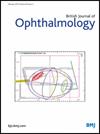Association of Chlamydia species with ocular adnexal mucosa-associated lymphoid tissue lymphoma in Taiwan.
IF 3.5
2区 医学
Q1 OPHTHALMOLOGY
引用次数: 0
Abstract
BACKGROUND Chronic antigenic stimulation, including autoimmune disorders and infection, may contribute to lymphoproliferation in specific tissues. Chlamydia species have been linked to ocular adnexal mucosa-associated lymphoid tissue lymphoma (OAML), with geographic variation in prevalence. This study explores the association between Chlamydia infection and OAML and correlates the presence of Chlamydia DNA with clinical features and treatment outcomes in Taiwan. METHODS Pathology specimens from 71 patients diagnosed with primary OAML were analysed for the presence of Chlamydia species, including C. psittaci, C. pneumoniae and C. trachomatis DNA, using touchdown enzyme time-release PCR. Demographic and clinical data, including age, sex, lymphoma location, staging and treatment modalities, were compared between Chlamydia DNA-positive and negative groups. Treatment outcomes such as relapse rates, survival time and treatment response were also analysed. RESULTS Among the 71 OAML specimens, 27 (38%) tested positive for C. trachomatis DNA, with two cases also positive for C. pneumoniae DNA. Chlamydia positivity was significantly associated with orbital involvement (p=0.020). No differences were found between the two groups in terms of disease staging, treatment methods, relapse rates, survival time and treatment response at last follow-up. CONCLUSIONS The study is the first regional report elucidating the association between Chlamydia and OAML in Taiwan. The findings suggest a possible link between C. trachomatis and orbital involvement in OAML. Further large-scale and prospective studies are needed to clarify the role of Chlamydia in OAML pathogenesis and to evaluate the potential benefits of antibiotic therapy in the patient population.台湾衣原体种类与眼附件黏膜相关淋巴组织淋巴瘤之关系。
慢性抗原刺激,包括自身免疫性疾病和感染,可能有助于特定组织的淋巴细胞增殖。衣原体种类与眼附件粘膜相关淋巴组织淋巴瘤(OAML)有关,其患病率存在地理差异。本研究探讨台湾衣原体感染与OAML的关系,以及衣原体DNA的存在与临床特征和治疗结果的关系。方法对71例原发性OAML患者的病理标本采用触地酶缓释PCR法检测鹦鹉热衣原体、肺炎衣原体和沙眼衣原体DNA。比较衣原体dna阳性组和阴性组的人口统计学和临床资料,包括年龄、性别、淋巴瘤位置、分期和治疗方式。治疗结果如复发率、生存时间和治疗反应也进行了分析。结果71例OAML标本中沙眼原体DNA检测阳性27例(38%),肺炎原体DNA检测阳性2例。衣原体阳性与眼眶受累显著相关(p=0.020)。末次随访时,两组患者在疾病分期、治疗方法、复发率、生存时间、治疗效果等方面均无差异。结论本研究在台湾地区首次报道衣原体与OAML的关系。研究结果表明,沙眼衣原体与OAML的眼眶受累之间可能存在联系。需要进一步的大规模和前瞻性研究来阐明衣原体在OAML发病机制中的作用,并评估抗生素治疗在患者群体中的潜在益处。
本文章由计算机程序翻译,如有差异,请以英文原文为准。
求助全文
约1分钟内获得全文
求助全文
来源期刊
CiteScore
10.30
自引率
2.40%
发文量
213
审稿时长
3-6 weeks
期刊介绍:
The British Journal of Ophthalmology (BJO) is an international peer-reviewed journal for ophthalmologists and visual science specialists. BJO publishes clinical investigations, clinical observations, and clinically relevant laboratory investigations related to ophthalmology. It also provides major reviews and also publishes manuscripts covering regional issues in a global context.

 求助内容:
求助内容: 应助结果提醒方式:
应助结果提醒方式:


